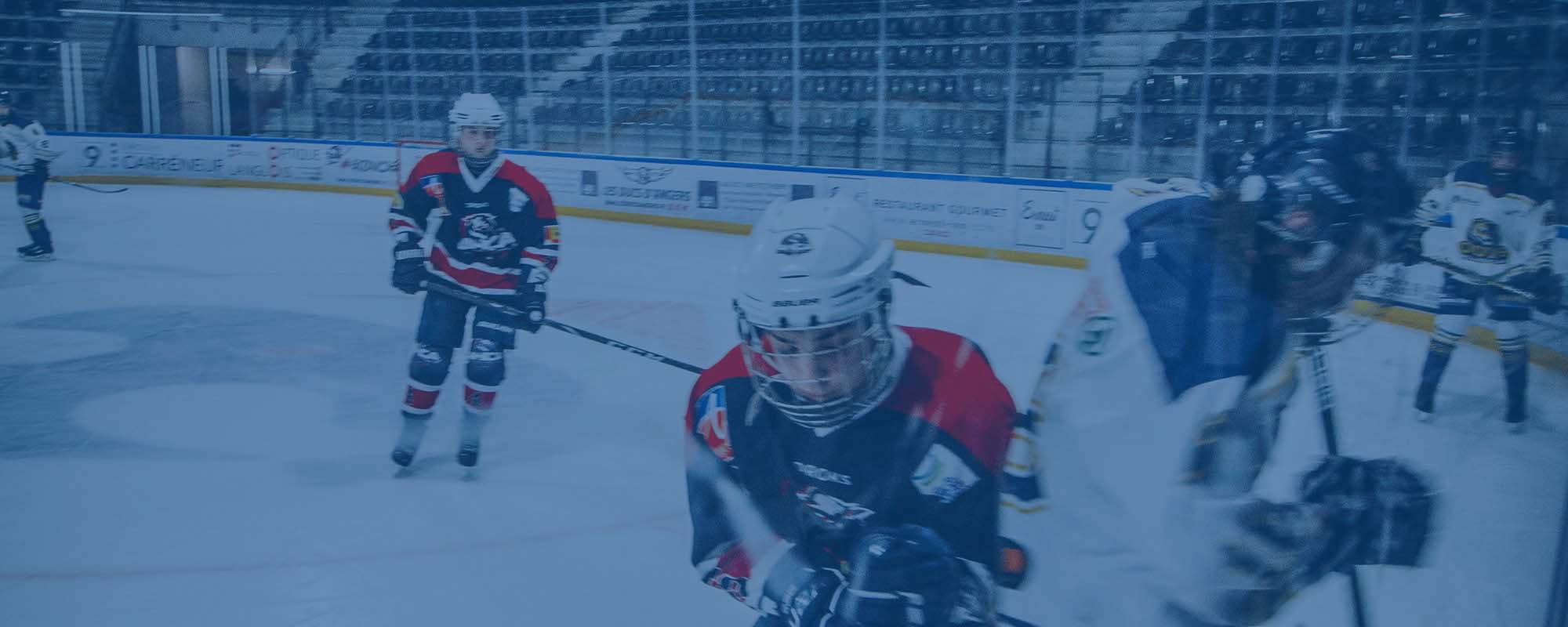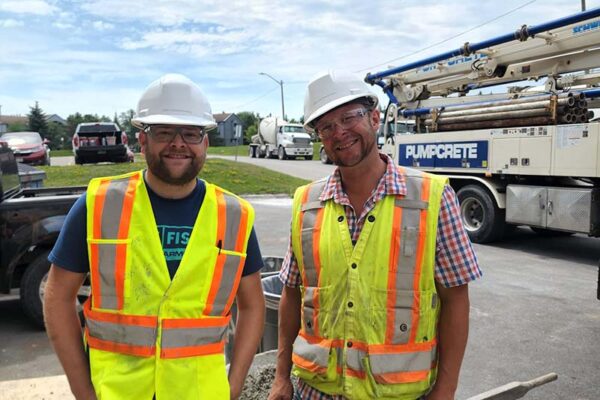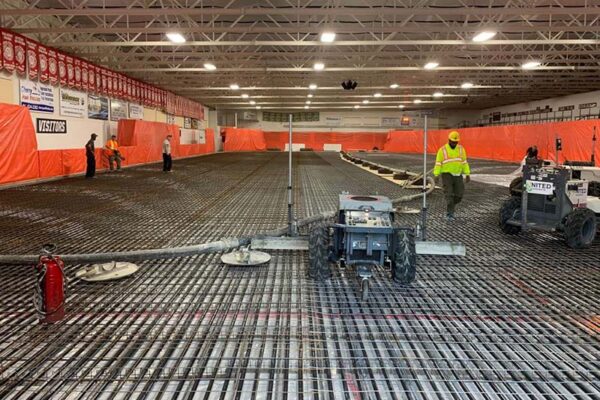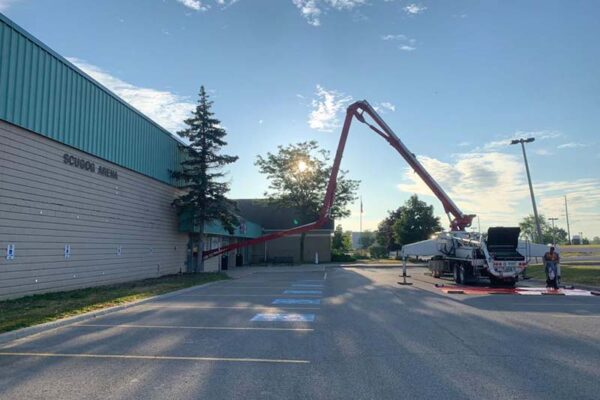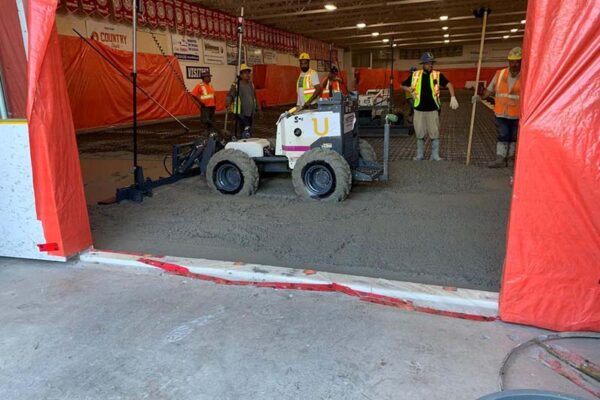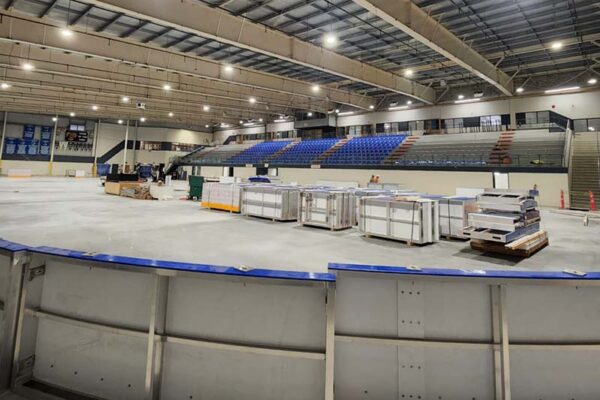Concrete Testing for Ice-Rinks: Overview
When watching hockey games or skating on indoor ice, we are not typically thinking about the quality of concrete beneath the surface of the ice. A flat concrete surface, free from depressions or damage from the freezing process provides the best foundation to lay high quality ice and for a better game of hockey.
Crucial to the flatness of the concrete is the water to cement ratio, which if not properly managed can result in depressions on the concrete surface or plastic shrinkage of the concrete as the water evaporates. For that reason, it is critical that thorough, systematic testing of the concrete occurs to ensure a smooth even surface and to prevent cracking or other damage. At the scale of an ice rink – a mass concrete placement – the cost to remediate any issues with the concrete typically corresponds to its scale, so here an ounce of prevention is worth a pound of cure.
In 2022, PRI Engineering completed the concrete testing program for two ice rinks in Ontario, both ice pads at the Lindsay Recreation Centre, and Scugog Recreation Centre. In the following case study, we discuss the necessary steps to test concrete for mass concrete placements at ice rinks.
How are Ice Rinks Constructed: Layering is Key
There can be one or two layer of concrete underneath the ice – one for cooling and one for heating. Immediately below the ice is a layer of concrete. A system of pipes, similar to what is used for refrigeration, is used to cool the chilled concrete layer, and is what keeps the ice, icy. Below the first layer of concrete, there is a layer of insulation, and then sometimes a second heated layer of concrete. Often beneath the heated concrete, there is a base layer of sand and gravel, and below that a ground water drain.
In this case, PRI completed the testing program for the top layer of concrete only, and where creating a flat surface becomes of greater importance to laying a smooth ice surface.
The Challenge: Flat Concrete with Place for Water Expand and Contract without Cracking
The concrete can vary widely in its material composition, water and air content, which is why it’s essential to formulate and test concrete according to its end use. In the case of ice rinks, where flat concrete is critical to the ice surface, controlling the mix of water to cement is the first consideration. If the ratio of water to cement is too high, it will cause more voids in concrete filled with water. When the water evaporates during curing, it can leave depressions in the surface of the concrete, and which can affect the ice surface.
A second consideration is specific to the cold temperature of the ice rink and a matter of course consideration for cold climates, the stress of water expanding as it freezes. Air entrainment (microscopic bubbles in concrete) is used to reduce the pressure from water expanding as it freezes by providing space for it to move into. In contrast to entrapped air voids, present in all concrete and naturally occurring, entrained air is intentionally mixed into the concrete during production. This entrained air is critical to the performance of the concrete and so a high level of certainty regarding air content is required.
Crucial to the flatness of the concrete is the water to cement ratio, which if not properly managed can result in depressions on the concrete surface or plastic shrinkage of the concrete as the water evaporates.
The Solution: How Do we Ensure the Concrete is Flat and Resistant to Stresses?
PRI Engineering designed its testing program to reduce the likelihood of depressions and damage from cooling the floor without sacrificing the strength of the concrete slab. Every load delivered to the site must be tested to ensure that the concrete is consistent and within the design specifications. PRI completed three tests on-site: the slump test, air test, and temperature test and one at PRI’s CCIL certified laboratory, a concrete compressive test.
On-site Concrete Testing: Slump, Air Content, and Temperature
The Concrete Slump Test estimates the workability of the concrete, which correlates to the water to cement ratio. As per the name, the test measures how much the concrete “slumps” or collapses vertically. The more it collapses, the higher the workability of the concrete, and the higher the water ratio to cement. PRI conducted the test at the point of discharge from truck to pump and again at the end of the pump. The differences between the two points can result in significant differences in the test results and ultimately the materials behaivour.
The second test, the air content test, measures the ratio of air to concrete. Air in concrete occurs naturally (air entrapment), and intentionally (air entrainment) through chemical additives. There is an inverse relationship between air content and concrete strength; as the air content goes up, the strength of the concrete decreases. Additives are also costly, which is a second incentive to closely control the air content in concrete without sacrificing its resistance to pressure from water.
The last test we performed on-site measured the temperature of the concrete. Higher temperatures allow more bonds to form during the curing process and result in stronger concrete, and vice versa for lower temperatures. But concrete too hot will dry out too quickly, likely before it can develop its desired strength and be more prone to cracking.
Concrete Testing is Nothing without Communication
Testing is one part of the solution, the second is communication. The concrete technician and the contractor need to be in close contact at all times to ensure that any out-of-specification concrete is rejected before final placement.
Discussion: Where Would Hockey be without Geotechnical Engineers?
If you ask an engineer, they would say that a well-designed and tested concrete slab lays the foundation for high performance, fast hockey, and less maintenance. In other words, hockey wouldn’t be as great without engineers. As with any sport, the technology we use shapes the development and performance of the sport, and engineers are behind many of those advances. Next time, you watch a game of hockey, take a moment to remember all the hard work that went on behind the scenes constructing the rink, placing the concrete (and testing that concrete).
Mass placements of concrete ice rink requires experts in material testing as well as a well-equipped laboratory. The engineers and lab technicians at PRI are extremely skilled at what they do, and our geotechnical laboratory is stocked with state-of-the-art equipment to guarantee that you get the information you need to build your project with a solid foundation and certainty.
